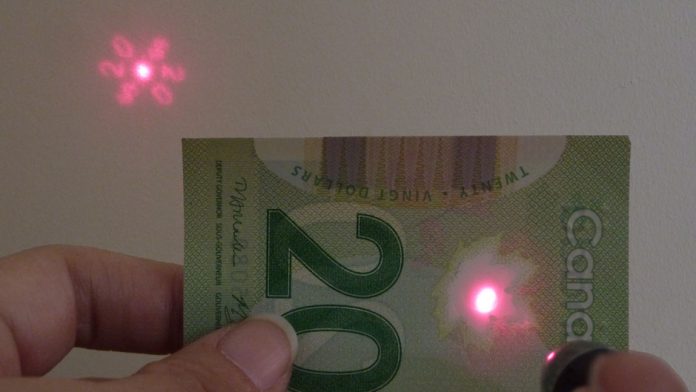To stay one step ahead of would-be counterfeiters, the Bank of Canada is always adding security features to Canadian banknotes. The change to polymer banknotes has opened up a wider range of possibilities, but one secret feature is hidden in plain sight.
Next time you open up your wallet, take a look for the maple leaf window. It has a clear border surrounding a frosted leaf. It turns out that leaf contains a hidden hologram of the denomination in a special material called a diffraction grating.
As science presenter Steve Mould explains in the video below, it’s easy to reveal the hologram using a laser light, or really any point of light. And now is a great time to check it out using holiday lights around your house or your neighbourhood.
Canadian banknotes contain a hidden hologram, revealed by any point source of light
Video courtesy of Steve Mould
This is definitely one to try at home! And to share with friends as a neat party trick. And don’t worry if you don’t have a laser pointer – if you look through the frosted window at any point source of light, you’ll see lines that radiate out of the light like the spokes of a snowflake, and it will read the denomination of the banknote (eg. $ 2 0 on a $20 bill).
I’ve been trying this all week, and almost any light will work, as long as it looks like a point of light. Multi-coloured holiday lights work really well to see how the hologram changes size with different colours (wavelengths) of light, but you can also try white lights to see the hologram halo in rainbow. Some other options for light sources include: your cell phone light; street lights and traffic lights; even the moon! If you find other sources that work, feel free to share them and any other observations, in the comments.
Of course, there is fun science at work here. Diffraction gratings demonstrate one of the basic principles of quantum mechanics: the wave nature of light.
Simply put, diffraction gratings are an array of slits that split up light into many directions, recombining into a different pattern on the other side. This is called interference, and it demonstrates that light behaves as a wave because the peaks and valleys of the wave can add up to boost one another, or to cancel one another out, leaving patterns of bright and dark areas that are distinct from the original pattern of slits.
If you’re interested in a deep dive, the video below from Khan Academy explains this visually.
Diffraction gratings demonstrate the wave nature of light
Video courtesy of Khan Academy
Want to try some more quantum experiments at home? Check out our blog post on electromagnetism and quantum levitation.








































